| **Station** | **Station ID** | **Login** | **Frequency** | **Remarks** | **Endorsement** |
| **ATIS** | ADL | EDDL\_ATIS | 123.780 | -- | -- |
| **Delivery** | DLC | EDDL\_DEL | 121.780 | -- | Tier 1: [EDDL\_GNDDEL](https://core.vateud.net/my/endorsements "Your endorsements (VATEUD Core)") |
| **East Ground** | DLGE | EDDL\_E\_GND | 121.605 | primary | Tier 1: [EDDL\_GNDDEL](https://core.vateud.net/my/endorsements "Your endorsements (VATEUD Core)") |
| West Ground | DLGW | EDDL\_W\_GND | 121.680 | -- | Tier 1: [EDDL\_GNDDEL](https://core.vateud.net/my/endorsements "Your endorsements (VATEUD Core)") |
| **Tower** | DLT | EDDL\_TWR | 118.305 | -- | Tier 1: [EDDL\_TWR](https://core.vateud.net/my/endorsements "Your endorsements (VATEUD Core)") |
| **Approach** | DLA | EDDL\_APP | 128.555 | -- | Tier 1: [EDDL\_APP](https://core.vateud.net/my/endorsements "Your endorsements (VATEUD Core)") |
| Arrival (Feeder) | DLAT | EDDL\_F\_APP | 128.655 | -- | Tier 1: [EDDL\_APP](https://core.vateud.net/my/endorsements "Your endorsements (VATEUD Core)") |
| Sector Bottrop | BOT | EDDL\_BOT\_APP | 119.110 | -- | Tier 1: [EDDL\_APP](https://core.vateud.net/my/endorsements "Your endorsements (VATEUD Core)") |
| Departure | DLD | EDDL\_DEP | 121.355 | airborne frequency if DLD, DLA, BOT, or PADH is staffed; covers BOT top down | Tier 1: [EDDL\_APP](https://core.vateud.net/my/endorsements "Your endorsements (VATEUD Core)") |
**Maximum active Startup Approvals** at the same time (status SUG until DEP) per runway (use the vSID startup counter): **Single RWY OPS:** 10 **Parallel RWY OPS:** 13 Depending on the traffic situation, only for a short time more startup approvals shall be used.
With startup Delivery transfers the aircraft to the responsible Ground station depending on the current stand. ### Enroute Clearance Runway 23L/05R is primary used for all departures. Delivery has to make sure that all SID restrictions are adhered to. The **SID MODRU #K** shall only be assigned on pilots request when able to comply with climb restriction (9.5%) and RF-Legs. Prior coordination with Tower is mandatory. Decision on short notice to the pilot by Ground or Tower is possible, depending on the preceding traffic (see Tower section). The **SID NETEX #K, #Y, #X, #U** are mandatory for flights to continue via NETEX DCT RASCA or NETEX DCT DELOM. To ensure an efficient operation within the upper and lower airspace several restrictions should be met (check FPC column in Euroscope). To solve an invalid route, the pilot usually has to file a completely new route (valid routes for many destinations can be found on [grd.aero-nav.com)](https://grd.aero-nav.com/ "grd.aero-nav.com").| **SID** | **Route** | **Restrictions** |
| **COL** | T911 | Flights to Frankfurt (EDDF) via COL must file a Requested Flight Level between FL150 and FL230 to ensure a correct sector order |
| **DODEN** | Y853 Y852 | Flights unable to comply with restrictions shall file via KUMIK |
| **GMH** | Z841 L603 | RFL 140- |
| **KUMIK** | Y854 L603 | RFL 150+ |
| **LMA** | Z282 | Only for flights to EDLN or local IFR (subject to coordination) |
| **MEVEL** | Z44 L179 Y850 | 23L/R: Max. 190kt IAS until on NOR Radial 001° |
| **MODRU** | Z717 Z283 | Cross MODRU FL 210 or above |
| **NETEX** | Z282 Z283 | Not to be used if military airspace in the north of the EBBU FIR is active. Information about the activation of the military areas can be obtained from the EBBU controller. |
| **NVO** | M170 Q760 | RFL 90- Flights with RFL 100+ shall file via MODRU |
| **NUDGO** | Z858 | RFL 245- |
| **SONEB** | P55 P64 |
Local departures need to be advised to contact **DLA** on 128.555 immediately after departure.
### Datalink Clearance (DCL/PDC) At Düsseldorf Airport we offer Datalink Clearance to the pilots via the **[Hoppie System](https://www.hoppie.nl/acars/ "Hoppie Datalink System")** and the Topsky Plugin. The airport code **EDDL** should be used (already preselected). An example of the DCL message the pilot will receive can be seen below. By default every outbound has to call Delivery for startup.CLD 2042 220117 EDDL PDC 026 SAS461L CLRD TO EKCH OFF 23L VIA MEVEL4T CLIMB 5000 SQUAWK 2055 ADT MDI NEXT FREQ 121.780 ATIS H REPORT READY ON 121.780
### High Traffic at EDDK During high inbound peaks into Cologne with 13 operations, Cologne Approach may use the Düsseldorf Approach sector. Therefore traffic departing Düsseldorf out of runway 23L/R to the south (COL, DODEN, NUDGO, GMH, KUMIK, NVO) require a **startup release** by Düsseldorf Approach. In case of startup delays, it might be useful to clear **outbounds to the south via MEVEL SID** and radar vectors to the filed first waypoint (no clearance via datalink for that). Additional coordination with APP required when this procedure should be used! > ... cleared XXXX via MEVEL4T, expect radar vectors to DODEN/KUMIK/NUDGO/COL/NVO, flight planned route... When the MEVEL SID is used, the flightplan need to be amended accordingly (e.g. "MEVEL DCT DODEN")**vSID:** Use the alias command "**.nosouth**<space><enter>" to disable the automatic vSID assignment for outbounds to the south. SIDs via "MEVEL DCT XXXXX" are highlighted.
# EDDL - Ground Düsseldorf Ground is responsible for all ground movements at the airport and can be split into east and west ground. If more than one ground is staffed, Delivery needs to be staffed first. ### Area or Responsibility The area of responsibility for each ground station can be seen on the image below. Each ground can only issue taxi clearances until the respective checkpoint. Any clearance beyond the checkpoints has to be coordinated. The handoff between ground stations should take place as early as possible so aircraft do not have to stop at one of the checkpoints > EWG1PM, hold short of Checkpoint 1, contact Ground on 121.605. [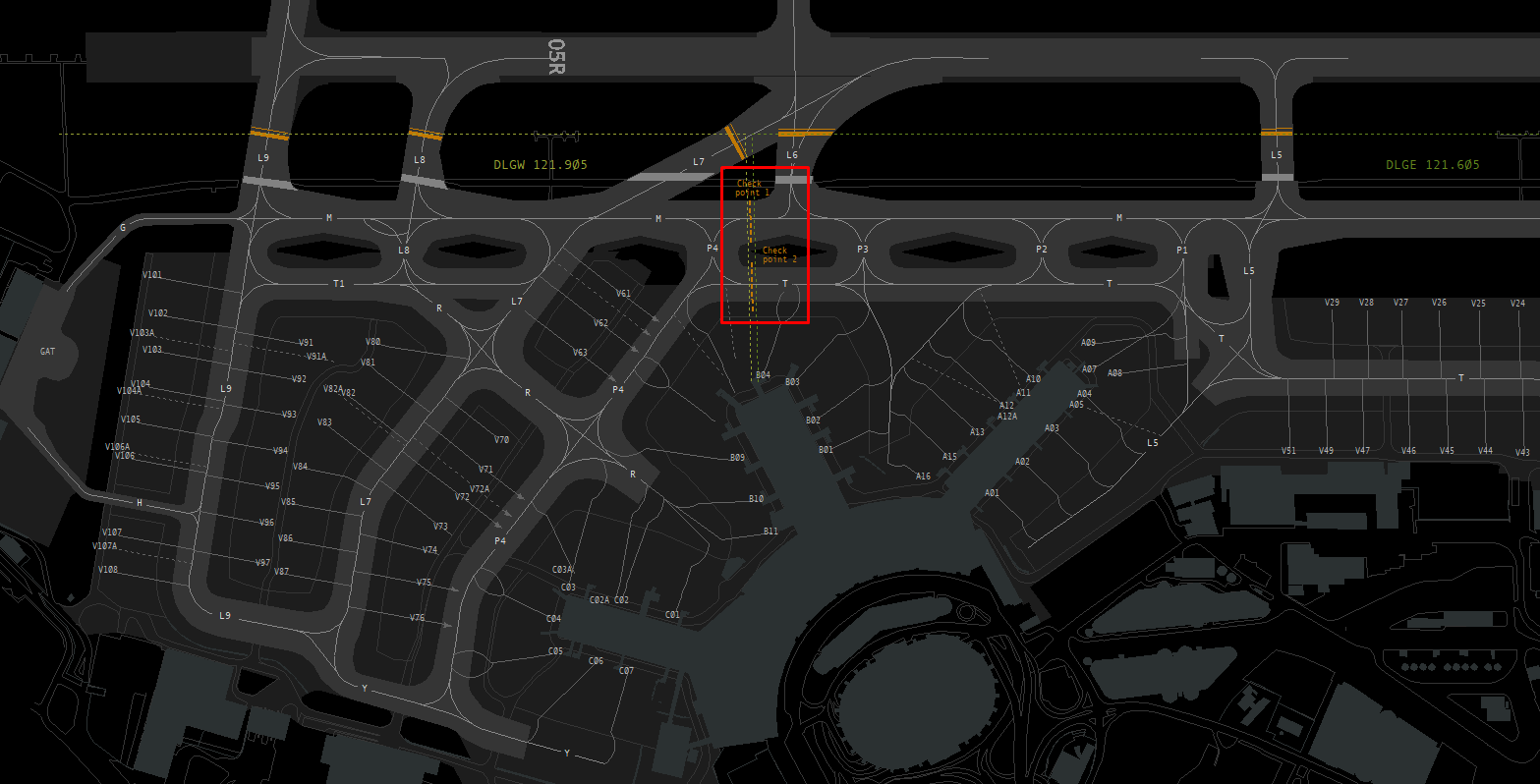](https://knowledgebase.vatsim-germany.org/uploads/images/gallery/2024-11/eddl-aor-gnd.png)*Sector Split Düsseldorf Ground West and East* ### Parking Positions Parking positions are assigned automatically for all inbounds according to the real life conditions by the Ground Radar Plugin. **Terminal A** is used by Lufthansa and Star Alliance Members for Schengen and Non-Schengen flights. **Terminal B** is only used for Schengen flights, while **Terminal C** is only used for Non-Schengen flights. V01 should not be used as parking position. The **A380** can only use Gate **C02A**. Stands V08B, V11B (and V38B if all other positions are occupied) are capable for the A388, but are not included in every scenery. With AIRAC 2511, the restructuring of the **East Apron** has (almost) been completed. The apron layout has changed considerably, with multiple stands being renamed or removed. Consequently, the sceneries no longer correspond to the current charts, so the stands have been temporarily disabled and can only be assigned, if pilots are informed of the changes. [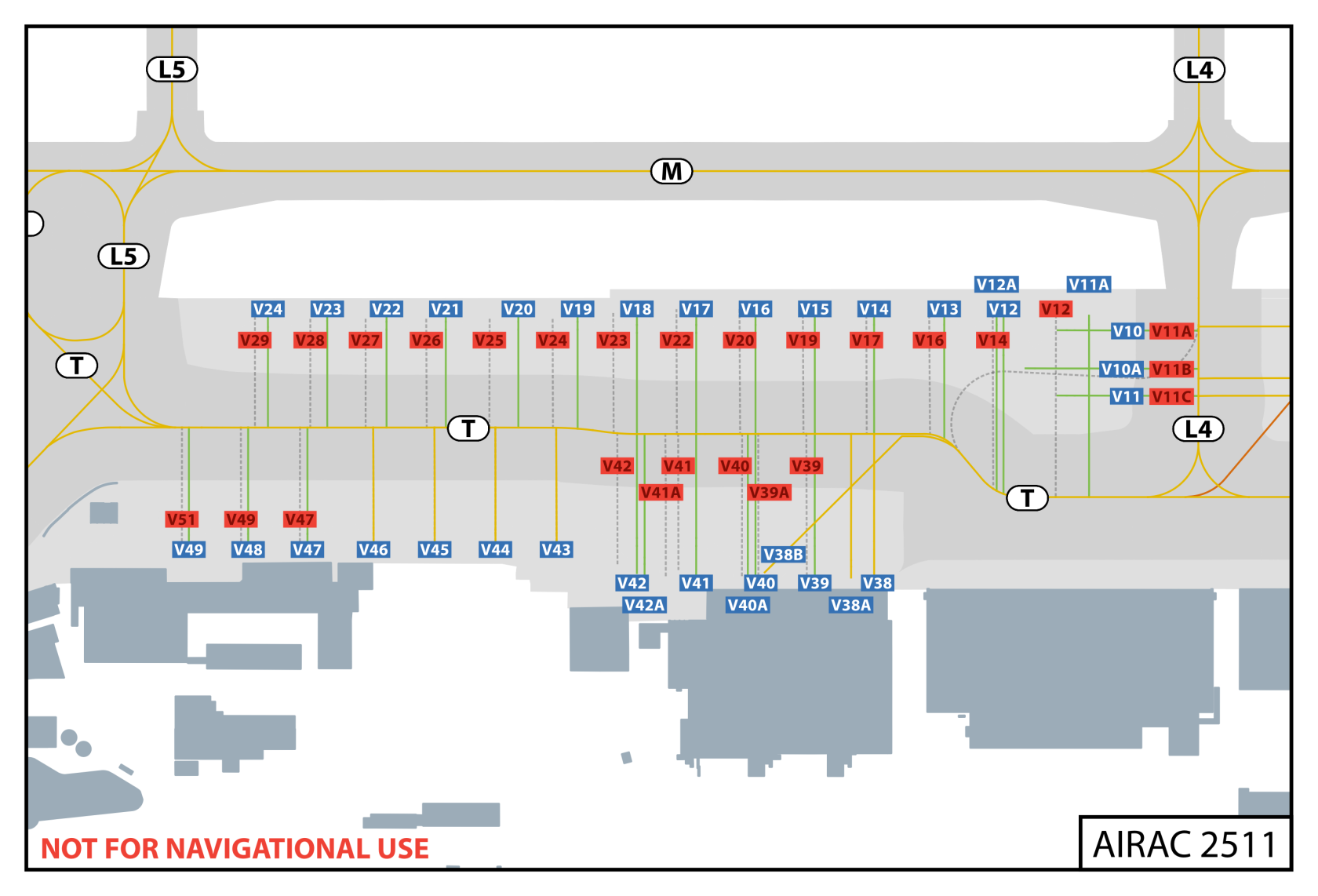](https://knowledgebase.vatsim-germany.org/uploads/images/gallery/2025-10/eddl-new-apron.png) *New East Apron Layout (green - new layout; grey - old layout)* ### Pushback All **Heavy** aircraft are not allowed to push into the "terminal bays". They always have to push on taxiway T or P4. In general only facings "north, south, west and east" are used. If traffic is instructed to push onto T or P4 this needs to be specified with the clearance: "Pushback approved, facing north, onto P4". Only stands V61 - V72 and V75, V76 are taxi out positions. All other positions (incl. V70, V73 and V74) require a pushback!To enable an efficient traffic flow, pushback onto Y, T, P4 and R can be used instead of the "terminal bays" for all medium aircraft. This way up to 3 aircraft can push simultaneously.
### GA Apron **Inbound** traffic to the GA Apron always needs to enter the apron via **taxiway H**. **Outbounds** parked south of the gas station (in the middle of the apron) will exit the GA Apron via **taxiway H**, outbounds parking north via **taxiway G**. The GA Apron is limited to aircraft with a maximum wingspan of 29 m. ### Taxiway Usage Taxiway M is *normally* used in the direction towards the holding point of the active runway, depending on the current operating direction. Taxiways P1-P4 connect the Apron with Taxiway M. #### Typical Conflicts **Apron-to-Taxiway M Intersections**: The most common ground conflicts occur at the intersection points where apron taxiways (P1, P2, P3, P4, etc.) meet the main taxiway M. Special care should be taken to keep scanning the junctions for possible conflicts. One of the multiple solutions for this type of conflict can be to either use "Taxi via" and hold the traffic in front of M. Alternatively a taxi instruction with a give-way can be used just as well. **Crowded holding point during 05 Operations:** Traffic approaching intersection L9 via M and via T1 have a high conflict potential when turning into the intersection. One of the multiple solutions for this problem can be to keep the junction before the holding point clear so the Tower can decide the departure sequence himself. #### Use of Intersections Ground will assign the intersections for departing traffic. The pilot always needs to be asked if able for an intersection when not using L1 or L9. This also applies to L2 and L8. Intersections a pilot is able for should be noted in the remarks. Outbounds shall be sent to Tower **as soon as they are clear of any conflicts**. Tower is always able to change the intersection according to the current traffic situation at the holding point and final. If possible, Ground should sequence the outbounds on M by north/south or different SIDs when they are departing into the same direction. **L2** is only used for "faster following" or WTS if there is no prior possibility to get outbounds in the best departure sequence on taxiway M. Consider taxiway restriction for overtaking traffic on L2. When there is no benefit (e.g. one inbound between two outbounds), L2 intersection should not be used. Only intersections with a published TORA (see charts) may be used for departures, even if the pilot reports that he would be able for a different intersection. As an exception, helicopters may depart from every part of the runway up to the runway end. Generally, an intersection may only be assigned to a departing aircraft when the pilot either reports by himself that he is able for that intersection or agrees to it after a controller’s request - regardless of the aircraft type. Intersections should not be used if there is no benefit for the outbound! #### Taxiway Restrictions - **Taxiway P1 and L5:** While one of these taxiways is occupied by a B744/B777/A350, the other one is restricted to a maximum wingspan of 60.5 m (largest possible aircraft A330/A343). - **Taxiway M and** **T/T1 between P1 and L9:** While one of these taxiways is occupied by an A380, the other one is restricted to aircraft up to a maximum of A310/B757. Parallel taxi is only possible for aircraft with a maximum wingspan of 65 m. - **Taxiway M and T at L3:** Taxiing from taxiway M onto T, and vice versa, via L3, is restricted to maximum code C aircraft. - **Taxiway L1 and L2:** L2 is restricted to a maximum of code E aircraft, as well as B777 and A346. Overtaking on L1 and L2 is only permitted for aircraft up to A330/A343 - **A380:** The A380 is limited to specific routings on the apron. All relevant restrictions, as well as the A380 taxi routings, are available as a Ground Radar Map (Functions -> Map Selection -> Restrictions). ### DE-ICING Areas During 23 operations De-Icing Area East (V01 - V11B) is used and during 05 operations De-Icing Area West (V61 - V72) is used. The detailed map is available as Ground Radar Map.| **DE-ICING Area - West** [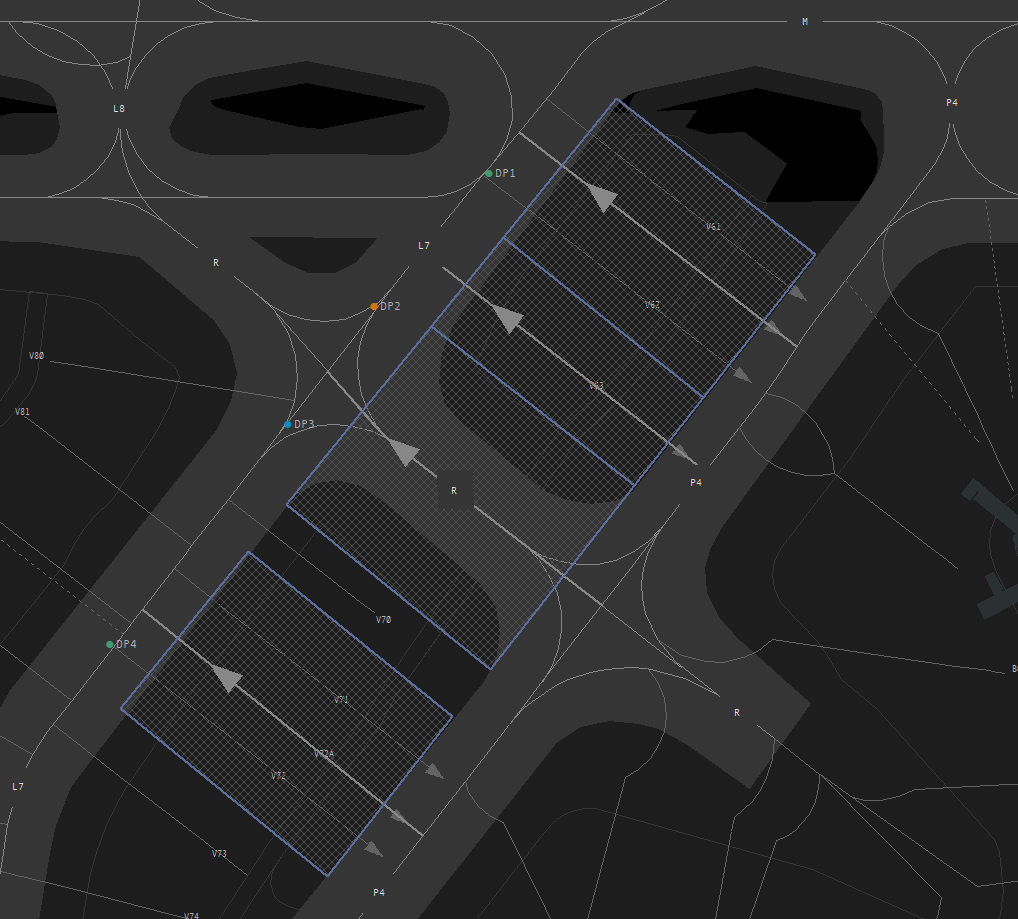](https://knowledgebase.vatsim-germany.org/uploads/images/gallery/2024-11/eddl-da-west.png) **DP1** - max. Code E **DP2** - max. Code C **DP3** - max. Code F **DP4** - max. Code E | **DE-ICING Area - East** [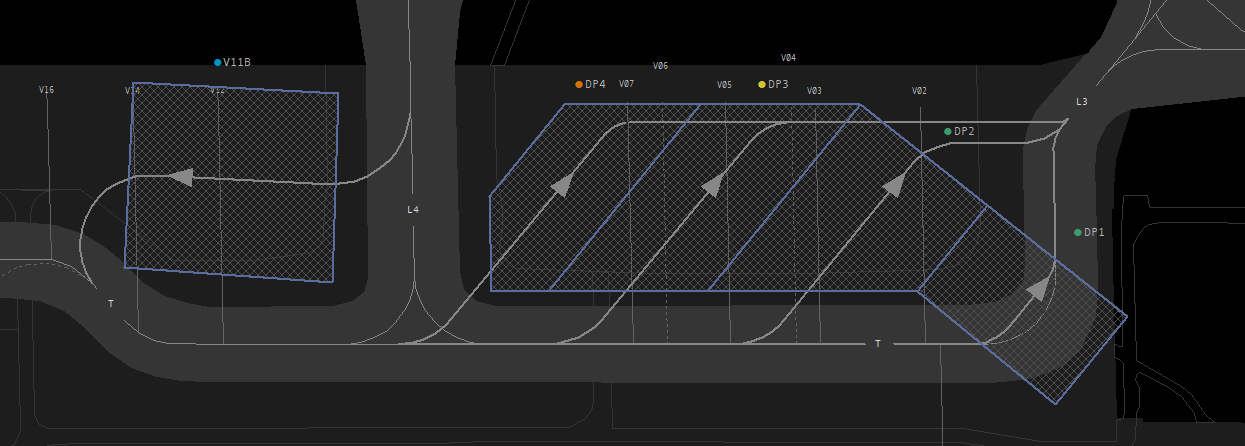](https://knowledgebase.vatsim-germany.org/uploads/images/gallery/2024-11/eddl-da-east.png) **DP1** - max. Code E **DP2** - max. Code E **DP3** - max. Code D **DP4** - max. Code C **V11B** - max. Code F |
It is **not** allowed to vacate/cross rwy 23L **via L7 and turn left on M**.
# EDDL - Tower Düsseldorf Tower is responsible for the runway system and traffic within the [Düsseldorf CTR](https://knowledgebase.vatsim-germany.org/link/1586#bkmrk-%C2%A0). ### Runway Usage Düsseldorf Aerodrome has 2 main operating modes: ##### Single Runway Operations: During single runway operations, the southern runway is used for all departures and arrivals, with the exception that VFR aircraft inside the traffic circuit **can** be allowed to use the northern runway to allow a more efficient flow between IFR flights and VFR traffic. During brief periods of higher simultaneous inbound and outbound traffic, it may be necessary to coordinate target spacing on final approach with Feeder. ##### Parallel Runway Operations During parallel runway operations, the southern runway is used for departures, while the northern runway is used for all arrivals. This configuration should be used when traffic volume exceeds (or will exceed) the capacity of single runway operations, as it allows for tighter inbound spacing and increased overall throughput. The A380 shall not use the northern runway and will always land on the southern runway without requiring prior coordination. ### Parallel Runway Dependencies The parallel runway system cannot be used for independent parallel approaches or independent parallel departures. Segregated parallel operations may be conducted when arrivals use the northern runway and departures use the southern runway, with the exception of runway 23L departures utilizing early right-turning SIDs (SONEBxT, MEVELxT, NETEXxT, and LMAxT departures). Controllers may issue takeoff clearances without waiting for landing completion on the parallel runway, provided the controller has both aircraft in sight and no increased probability of missed approaches or track deviations exists. This procedure shall not be used when wake turbulence separation would be required between a preceding departure or a potential missed approach overtaking the departure. During reduced visibility when visual contact cannot be maintained, the parallel runways must be treated as a single runway system, meaning a previously departing aircraft must have either overflown the end of the runway or initiated a turn before the landing aircraft crosses the threshold on the parallel runway. The procedure of not withholding takeoff or landing clearances can be applied while considering the parallel runways as one system. However, since there are physically two runways, landing clearance may be issued once the corresponding runway is clear, and takeoff clearance on the parallel runway may be given as soon as arriving traffic has touched down and begun decelerating. If runway separation cannot be guaranteed, any takeoff on the parallel runway must be aborted. Since the runways in Düsseldorf are less than 760 m apart, wake turbulence separation between both runways must be ensured at all times. #### Visual Swingover When traffic conditions allow, aircraft may be cleared for a visual swingover from the northern runway to the southern runway. Prior to issuing the visual approach clearance, pilots must report the southern runway in sight. Along with the visual approach clearance, controllers shall provide missed approach instructions, typically consisting of runway track and climb to 4000 feet, as a missed approach procedure does not exist for a visual approach. ### Arriving Traffic For inbounds, Düsseldorf Arrival is responsible for separation until transfer of communication. Düsseldorf Tower is responsible for maintaining separation of arriving traffic from transfer of communication until touchdown, if necessary by use of adequate means (e.g. speed control), and during the initial part of a missed approach. **Vacating RWY 05R:** Traffic vacating RWY 05R via L1, L3 or L4 (after landing or crossing) should be instructed by Tower to turn right on M. The handoff to Ground will take place thereafter. This will prevent traffic to stop in the intersection and blocking the runway during frequency change. Traffic vacating runway 05R (or 05L via K1) are not permitted to taxi into L2. #### Missed Approaches All missed approaches are subject to immediate coordination with the appropriate approach controller. Upon notification of a missed approach, DLA will normally issue the tower controller a heading for the aircraft. If no alternative instruction is provided by DLA, the missed approach will fly the standard missed approach procedure as published. Tower may take immediate action to reestablish separation if required, but must inform the approach controller without delay. The handover takes place once separation is established. The next departure requires a departure release. #### Runway Crossings Traffic landing on the northern runway will have to cross the southern runway, before being handed over to ground. Traffic vacating 23R via K3 shall cross the runway into either L7 and L6, depending on their assigned Gate and shall be handed over to either east or west Ground. This will reduce congestion around the Checkpoints and avoid unnecessary frequency changes. It is not allowed to vacate runway 23L via L7 and turn left on M. ### Departing Traffic All departures must be separated by at least 3 NM or wake turbulence separation, whichever is greater. If visual separation is used during VMC conditions to reduce initial departure separation, the tower controller has to ensure the succeeding aircraft remains on tower frequency until 3NM or 1000ft separation are ensured. During 23 Operations, it is necessary to observe the speed of both aircraft if initial separation is close to 3 NM, as the distance between both aircraft involved shrinks as soon as the first one starts its turn. Increased spacing on the same SID is **not** necessary, however precise monitoring of speeds is crucial and if the suceeding aircraft gets faster, the controller needs to react in terms of restrictive altitude instructions and/or restrictive speed instructions.**Rule of thumb for 23 Operations:** Generally, if the distance between the two departing aircraft is higher than 3.5 NM prior to a 90 degree turn minimum separation should not be less than 3 NM provided that the preceding departure is faster.
**MODRU/NETEX #T** followed by **\#K** requires at least 4 minutes separation due to the shorter routing. Depending on the outbound sequence on taxiway M it might be useful not to use #K SIDs. If separation has to be reestablished, such as during a missed approach on short final with departing traffic already airborne, or when departure spacing becomes too tight, transfer of communication shall take place only after Tower has ensured proper separation. In such situations, it may be necessary to instruct a departing aircraft to "remain on tower frequency" until separation is established. **Transfer of Communication or "Auto Handoff":** Usually all departures on a SID have to contact Langen Radar according to the charts on their own when passing 2000ft AMSL. Departure frequency shall be published in the ATIS. Independent lineup is possible for all intersections **with traffic information** for the second departure. Intersection L2 should only be used if there is a real benefit for departures.| **Runway** | **Preceding CAT 1/CAT 2** **succeeding CAT 1** | **Preceding CAT 1/CAT 2** **succeeding CAT 2** | **Preceding CAT 3** **succeeding CAT 1/CAT 2/CAT 3** |
| **05L/23R** | 600m | 1500m | N/A |
| **05R/23L** | 600m | 1500m | 2400m |
DLA has to inform DUS Tower when this agreement is in operation!
#### Important Areas The Dortmund Area (shown in red) is between GND and FL65 and permanently operates under PADL's responsibility for all Dortmund inbound and outbound flights. Düsseldorf Arrival must keep aircraft at or above FL70 in this area. When operating below this altitude, each aircraft requires an individual release from PADL. The TEBRO Area (shown in orange) spans from FL205 to FL245 and permanently operates under EHAA's control. Amsterdam departures pass through this area. [](https://knowledgebase.vatsim-germany.org/uploads/images/gallery/2025-12/ebg1-areas-2513.png)*Important Areas* ### Feeder - Düsseldorf Arrival (former Director) (DLAT) Düsseldorf Arrival can be split into two units to distribute the workload along two controllers with a lot of traffic. DLAT takes on the tasks of the feeder, while DLA handles the tasks of the so-called pickup. Both operate within the same airspace, so there are no fixed transfer conditions. However, certain aspects should be taken into consideration: - The pickup ensures that the aircraft have the correct ATIS, inform a/c about runway to land, and establishes a sequence. This is achieved by using speeds, vectors, or transitions, as well as appropriate and separated levels. Coordination of the sequence between both units is not required, as long as the pickup transfers the aircraft to the feeder in the order planned for the sequence. Any deviation from this order should always be coordinated. - The feeder's task is to line up the aircraft on final approach with optimal spacing. The minimum spacing for the same runway is 3.0 NM. If the aircraft are landing on different runways, the separation can be reduced to 2.5 NM within 10 NM of the threshold. - At the same time, there is a constant effort to balance the workload between both units. The pickup may also be occupied with other problems in the sector, which justifies the presence of a feeder even during heavy inbound traffic. Additionally, a feeder can, for instance, handle IFR cancellations for Essen inbounds on runway 23 or manage Mönchengladbach in- and outbounds during 05 operations, thereby relieving the pickup. This often makes sense because the feeder is already separating inbounds in this area anyway, which also reduces coordination to a minimum. - If the pickup is very busy however the feeder has less traffic, handoffs can be done early and without sufficient spacing, vectors or speeds as long as separation exists. In this case the feeder has the capacity to establish sufficient spacing and is able to reduce the workload of the pickup controller. - The workload balancing also works in the opposite direction. If the feeder becomes very busy and reaches his capacity limits, the pickup must ensure that aircraft are sent as simply and uniformly as possible. In such cases, aircraft should be transferred with sufficient spacing on the downwind at FL70 or FL80 and a speed of 220 knots. Significant deviations from the downwind make the feeder's job harder. If the aircraft are too low, there is a risk of entering the PADL Wickede during 23 operations. Additionally, this provides the feeder with enough levels to work with vertical separation effectively. ### Reduced Minimum Radar Separation Minimum separation of IFR flights approaching the parallel runway system (23L & 23R or 05L & 05R) can be reduced to 2.5 NM, according to AIP, if no **wake turbulence separation** has to be applied: > Reduced Minimum Radar Separation for Diagonal Staggered Approaches (Based on NfL I - 9/09) > > 1. The Minimum Radar Separation (MRS) for diagonal staggered approaches to parallel runways at Düsseldorf Airport is 2.5 NM between 10 NM and the touchdown point. > > 2. The reduced MRS will be applied to landing directions 05 and 23, provided > the following conditions are met: > \- Preceding and succeeding aircraft are approaching different parallel runways. > \- Both aircraft are established on the final approach track. *Quote from AIP Germany/AD 2 EDDL 1-23 (by the German Luftfahrt-Bundesamt), applicable on VATSIM.* ### Sector Bottrop (BOT) Sector Bottrop is responsible for the lower airspace approximately north of Düsseldorf and a small part above the arrival sector. In addition to arrivals and departures for Niederrhein-Weeze (EDLV) and the Geilenkirchen military airfield (ETNG), its tasks primarily include through flights to and from Düsseldorf. [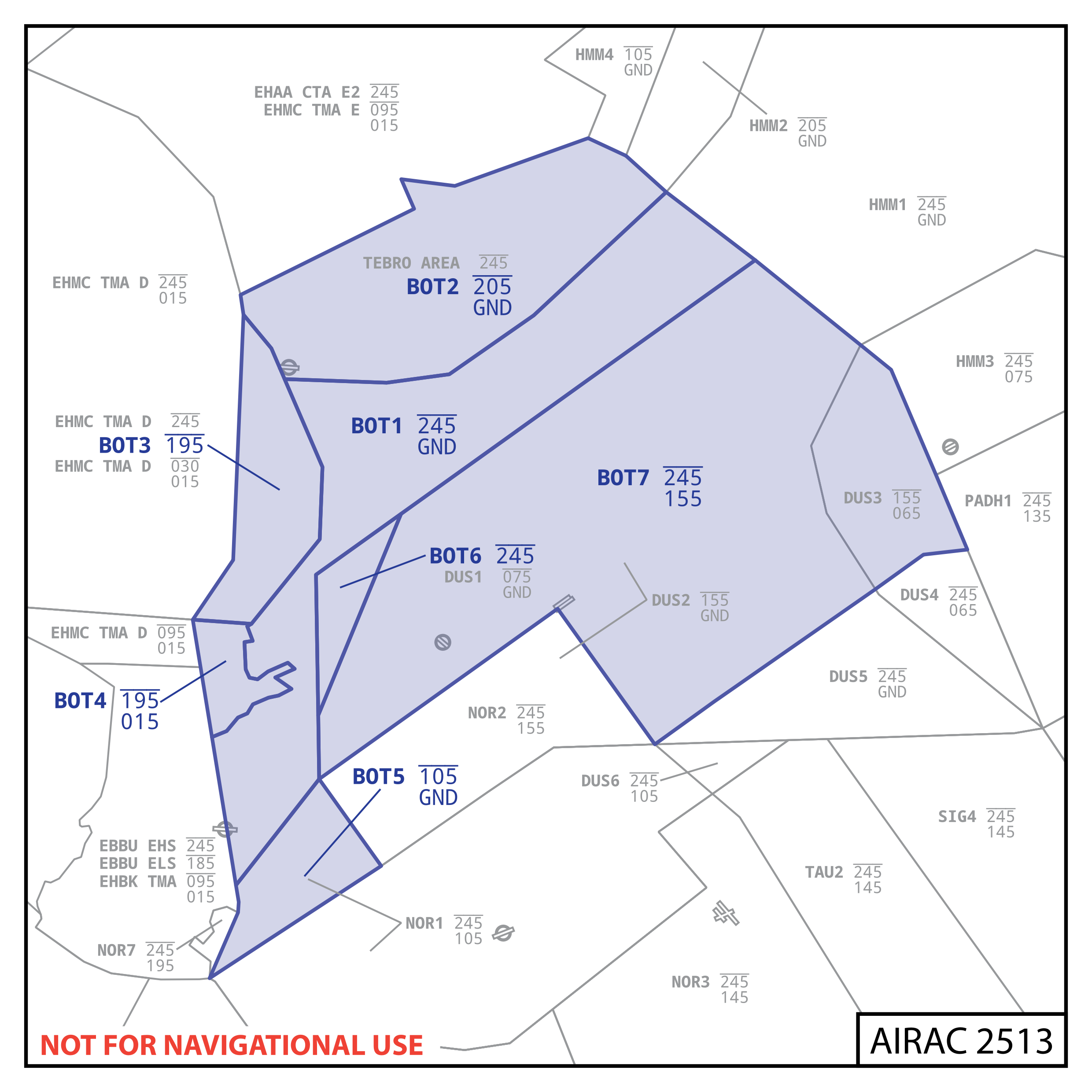](https://knowledgebase.vatsim-germany.org/uploads/images/gallery/2025-12/bot-2513.png)*Sector Bottrop (BOT)* If the Bottrop sector is not staffed separately, it is taken over by Düsseldorf Approach by default. **Flights through BOT:** In addition to the flights to and from Düsseldorf, there are also flights in lower airspace and to destinations in the Netherlands, Belgium and Luxembourg. The respective transfer altitudes are published in the respective LoA. Flights to **Münster/Osnabrück (EDDG)** via BAMSU must be cleared for the BAMSU#J arrival before the transfer to the HMM sector takes place. ### Düsseldorf Departure (DLD) Düsseldorf Departure is responsible for departures out of Düsseldorf EDDL and Mönchengladbach EDLN. According to the departure procedures, pilots have to contact Departure when passing 2000ft AMSL. [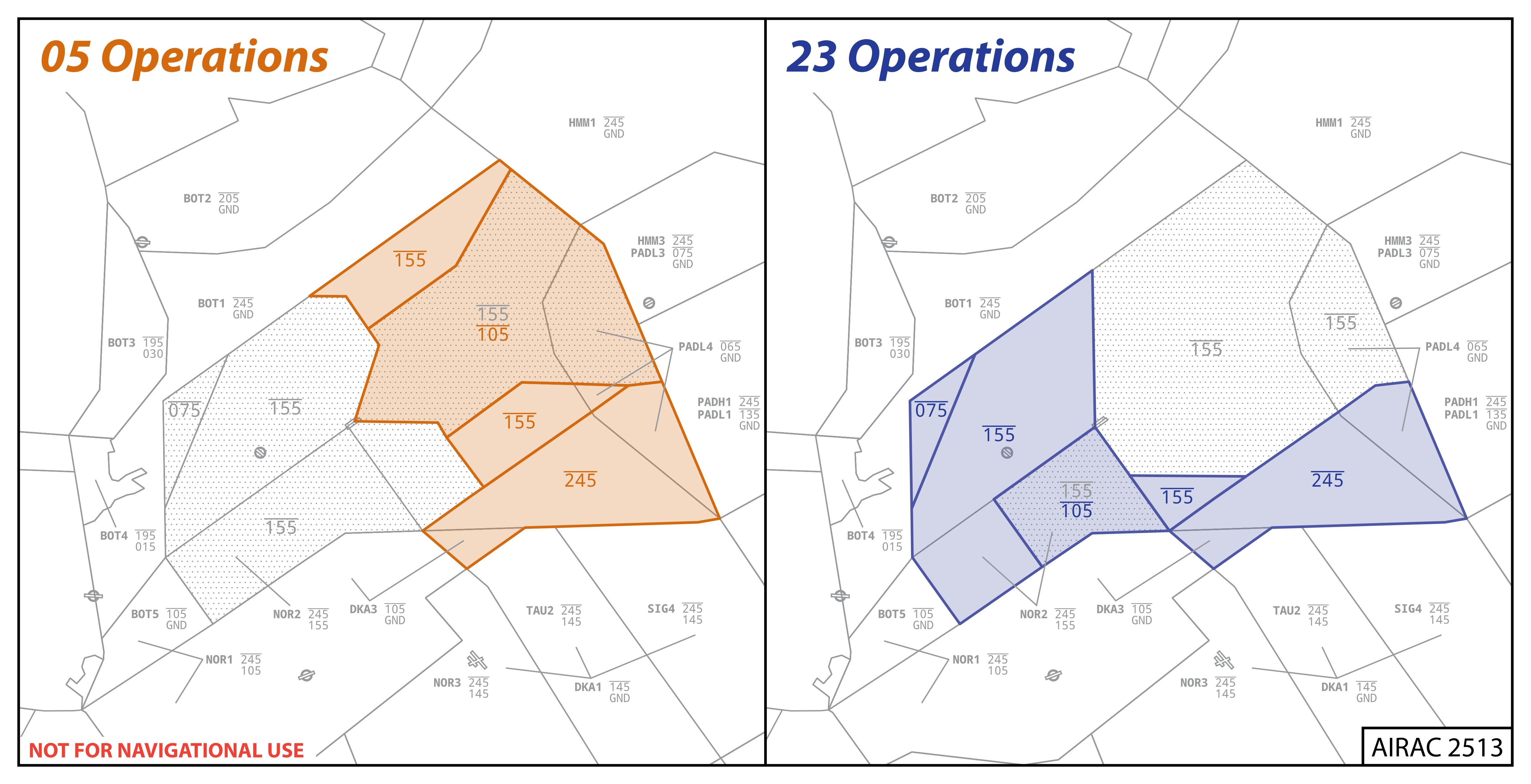](https://knowledgebase.vatsim-germany.org/uploads/images/gallery/2025-12/dld-2513.png) *Düsseldorf Departure shares sector DUS with Approach* ### Frisbee Radar (TNGA) The military approach sector Frisbee Radar is responsible for all departures from Geilenkirchen's (ETNG) runway 09 and approaches to Geilenkirchen's runway 27. The transfer conditions for all approaches to runway 27 must be coordinated individually with Frisbee Radar. Departures from runway 09 flying an SID will be handed over at the sector boundary at 3000ft at the latest, unless otherwise coordinated; for departures on an OID, the handover conditions will be coordinated individually by Frisbee Radar. Frisbee Radar always has to obtain a release by BOT for all departures. [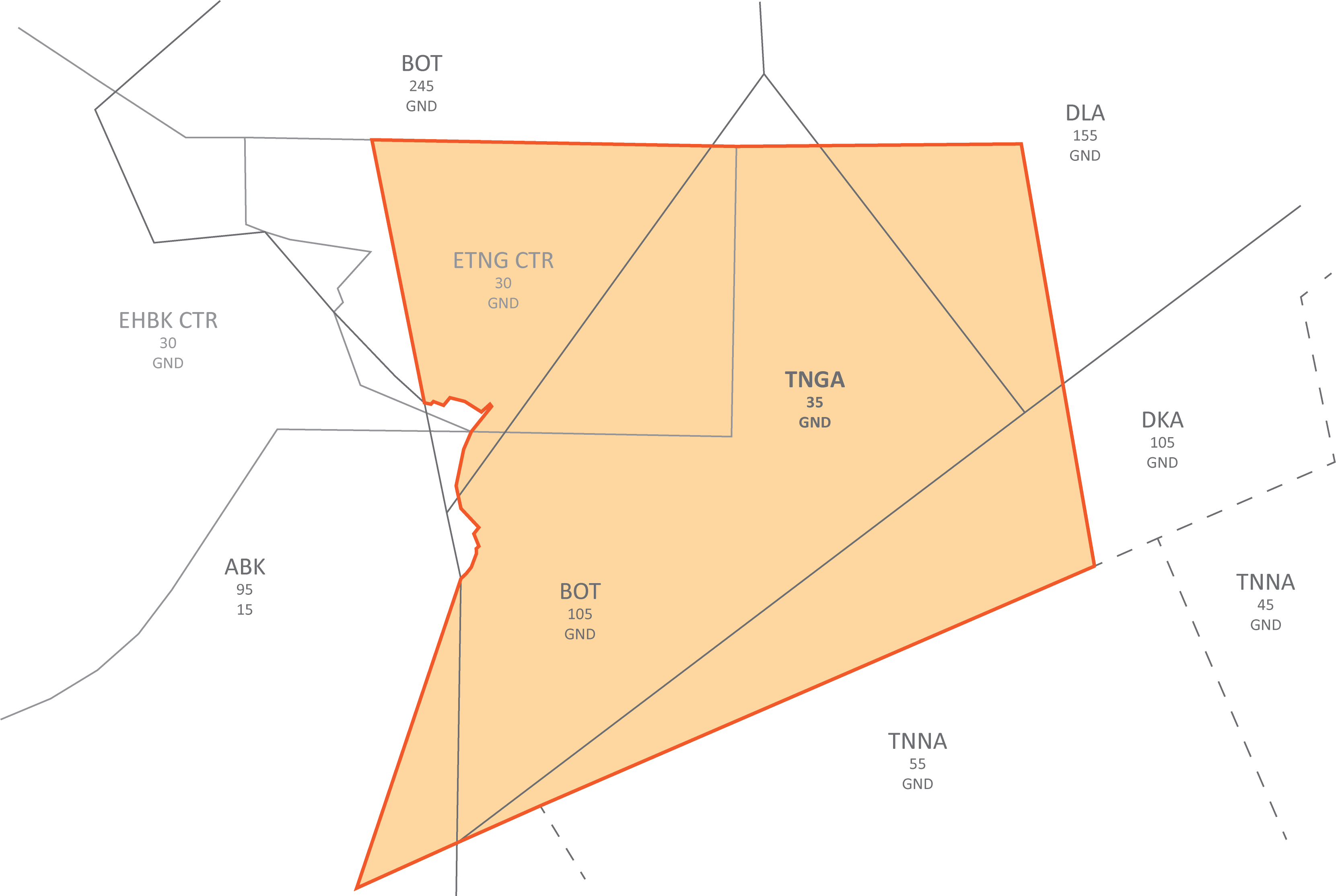](https://knowledgebase.vatsim-germany.org/uploads/images/gallery/2024-11/etng.png)Charts for military airfields are available within the german [Military-AIP.](https://www.milais.org/publications.php "milais.org") ### Potential Conflicts #### 05-Operations - After a short time, all outbounds on a SID cross the STARs or transitions of the inbounds (north via HALME, south via DOMUX). The outbound flights should be below (max. FL90) the inbound flights (min. FL100). After passing the crossing point, descent and climb can be continued. - The STARs and transitions originating from PISAP, HALME and BIKMU ultimately all meet north of the airport at point GAPNU. Those from DOMUX and ELDAR (05 operations only) meet to the south at point DL502. Good advance planning and pre-sorting for the final approach is recommended here. - The MODRU/NETEX SID not only crosses the approaching traffic coming via HALME, as mentioned above, but also the approaching traffic coming via PISAP. Whenever possible, attempts should be made to guide departing aircraft over the approaching aircraft. - Both departures and arrivals can come via the LMA NDB. Here too, it is advisable to stagger the traffic vertically and initially keep departures below the arrivals until there is no longer a conflict for the further climb or descent clearance. - EDLN departures from runway 13 cross the EDDL final approach shortly after departure. Mönchengladbach Tower therefore always requires a departure release from DLAT for 13 operations. In this case, DLAT and DLA should coordinate a sufficient gap between EDDL approaches and, if necessary, issue the departure release with the condition of an immediate take-off. - EDLN approaches to runway 31 cross the EDDL final approach. DLAT and DLA should coordinate a sufficient gap between EDDL approaches. It also makes sense for DLAT to guide the EDLN approach to the final approach. #### 23-Operations - All aircraft departing via the southern SIDs cross the traffic approaching via BIKMU. As this crosses BIKMU at FL140, departures should initially be kept below FL140 and cleared for further climb after passing the conflict area. - All STARs and transitions from points BIKMU, LMA, PISAP and HALME end at BOT NDB or meet at points XAMOD and DL426. Good advance planning and pre-sorting for the final approach is recommended here. - Both departures and arrivals can come via the LMA NDB. Here too, it is advisable to stagger the traffic vertically and initially keep departures below the arrivals until there is no longer a conflict for the further climb or descent clearance. - EDLN departures from runway 13 are not necessarily separated from EDDL departures, depending on the respective climb rates. Mönchengladbach Tower therefore always requires a departure release from DLD for 13 operations. DLD should therefore pay particular attention to separation in this situation. If necessary, DLD can also instruct Düsseldorf Tower to hold departures briefly to enable a safe EDLN departure. ### Holdings In case holdings are required, traffic should be held by Approach and only the lowest inbound aircraft should be sent to the Feeder. These holdings should be used with caution as they are directly in the downwind sector. - **DUS** (min. 3,000 ft AMSL, max. 24,000 ft AMSL) - **DLA503** and **DLA524** - 05 operations (min. 4,000 ft AMSL, max. FL070) - **DLA409** and **DLA429** - 23 operations (min. 4,000 ft AMSL, max. FL070) #### Enroute-Holdings As the above-mentioned holdings partly block the arrival sector and make working more difficult, published enroute holdings are preferably used for Düsseldorf. - **ADEMI** (DOMUX Arrivals - min. 6000ft AMSL - Inbound 284° - Left) - **HMM** (HALME Arrivals - min. 5000ft AMSL - Inbound 257° - Left) - **DOMEG** (HALME Arrivals - min. 5000ft AMSL - Inbound 170° - Left) - **ELDAR** (BIKMU Arrivals - min. 6000ft AMSL - Inbound 358° - Left) - **NVO** (BIKMU Arrivals - min. 6000ft AMSL - Inbound 068° - Right) ### Crosscoupling of Approach Frequencies Düsseldorf Approach (EDDL\_APP) cross-couples all other EDDL\_X\_APP frequencies via XC in Audio for VATSIM. This enables us to always use the correct departure frequency (published on the charts) when the approach/departure is staffed. When EDLN is staffed, the controllers there must always be informed of the active operating direction in EDDL.